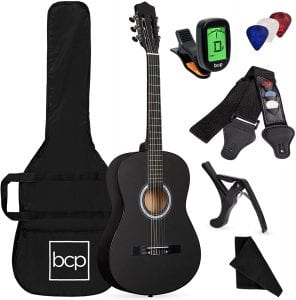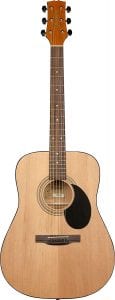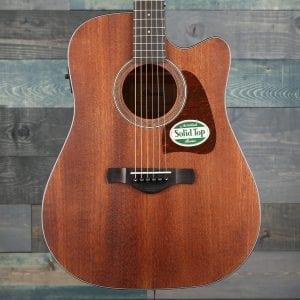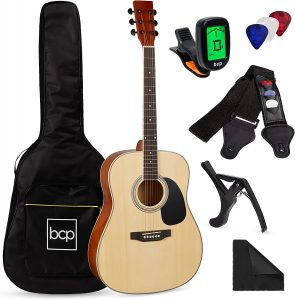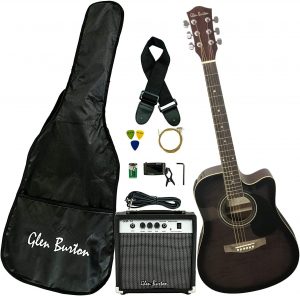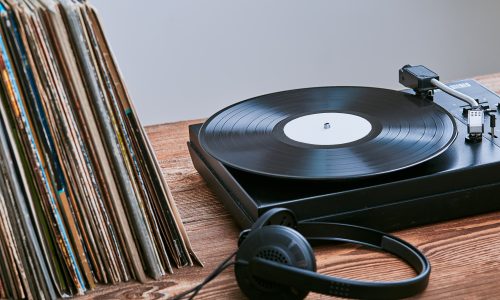The Best Acoustic Guitar
We looked at the top 20 Acoustic Guitars and dug through the reviews from 73 of the most popular review sites including and more. The result is a ranking of the best Acoustic Guitars.

Our Review Process
Don't Waste Your Money is focused on helping you make the best purchasing decision. Our team of experts spends hundreds of hours analyzing, testing, and researching products so you don't have to. Learn more.
Our Picks For The Top Acoustic Guitars
- 1. Best Choice Products Rosewood Beginner Acoustic Guitar
- 2. Master Play Easy Tuning Beginner Acoustic Guitar
- 3. Ashthorpe Basswood Entry-Level Acoustic Guitar
- 4. Fender Mahogany Wood Slim Acoustic Guitar
- 5. WINZZ Handcrafted Linden Acoustic Guitar
- 6. Jasmine S35 Dreadnought Acoustic Guitar
- 7. Ibanez AW54CEOPN T-Bar Undersaddle Solid Top Acoustic Guitar
- 8. YMC Teardrop Shaped Ebonized Acoustic Guitar
- 9. Kadence Built-In Truss Rod Wooden Acoustic Guitar
- 10. Donner Student Mahogany Acoustic Guitar Kit
- 11. Yamaha Classic Rosewood Acoustic Guitar
- 12. Yamaha FD01S Solid Spruce Wood Top Acoustic Guitar
- 13. Ibanez AW54OPN Solid Top Natural Acoustic Guitar
- 14. Fender CD-60S Easy Playing Picking Acoustic Guitar
- 15. Fender CC-60S Starter Pack Right Handed Acoustic Guitar
- 16. Fender 6 Slim Beginner Acoustic Guitar
- 17. Jasmine Satin Finish Acoustic Guitar
- 18. Epiphone DR-100 Tapered Neck Acoustic Guitar
- 19. Best Choice Products Foam Padded Bag & Acoustic Guitar
- 20. Glen Burton Steel String Cutaway Acoustic Guitar
For the price, you'll be hard-pressed to find a beginner-designed acoustic guitar of this quality. It's lightweight and small, making it easier for younger players. It also comes with plenty of extras, including a guitar pick and shoulder strap. More advanced players may find this particular guitar lacking, but it's perfect for someone who just wan...
Lightweight ModelQuality is the best word to describe this acoustic guitar, which features steel strings and a sturdy wood construction.
With over 10 different finishes to choose from, you'll find this acoustic guitar comes in a shade that matches your personality. The 38-inch guitar is designed for those who are new to the instrument. It offers a solid wood construction and comes with a host of accessories, including a storage bag, shoulder strap and set of guitar picks.
Budget-Friendly OptionYou'll love the affordable price tag on this acoustic guitar, which makes it possible for beginners to get a feel for the instrument.
It's never too late to learn how to play a new instrument and that's where this acoustic guitar comes in. It's designed for beginners and comes with a shoulder strap, three picks, a tuner, extra strings and a gig bag. The guitar is constructed from a high-quality basswood, so it's nice and lightweight.
Choice of ColorsYou'll find this acoustic guitar comes in a choice of colors, including red, black, blue, natural and sunburst.
Beginners will love that this acoustic guitar comes with everything you need to begin making sweet music. It sounds great no matter what genre of music you identify with most and is made with a beautifully laminated spruce top. Included with the guitar are three picks, a strap, a tuner, strings, a beginner's DVD and a gig bag.
High-Quality SoundWhether your a little bit country or a little bit rock and roll, this acoustic guitar is a great buy.
Buying Guide
If you’ve always wanted to learn to play guitar, you aren’t alone. In fact, research has found that learning to play the guitar can improve a person’s quality of life. For that reason, it’s no surprise that an increasing number of people are picking up the guitar for no other purpose than to have fun.
Whether you have aspirations of becoming a professional musician or you simply want to entertain at parties, an acoustic guitar will get you started. Buying a guitar is easier than ever, with models available for every experience level. But before you start shopping for one, you’ll likely want to know the most important features.
Sound is, of course, of top priority. It can help to first know how an acoustic guitar works so that you’ll find one that puts out the best audio. Although you make music by moving your fingers over the strings, they actually make very little noise themselves. The sound comes from the way the vibration of the string is transferred by the bridge and saddle to the body of the guitar. This setup describes why the size and build of the entire guitar play an important role in the music you get from it.
Beyond the way your guitar sounds, though, it’s important to consider the look and feel of it, says Lewis McGehee, a professional guitarist, songwriter and private guitar teacher.
“A guitar is very personal,” McGehee says. “It needs to feel good, look good and sound good to you, which are all very subjective things. Everyone’s hands and bodies are different, which can determine how you hold and play a guitar.”
McGehee also recommends keeping the intended use of your new guitar in mind while you shop.
“Is your primary goal to have it strictly for personal use around your home or do you want to play it at an open mic? At your church? In a band?” he says.
Some guitars are smaller and lighter than others, so keep that in mind as you shop. You’ll also have the choice between various body styles, including the popular dreadnought or concert guitar body type. The latter is often more popular with beginners, who eventually graduate to dreadnought as they evolve.
You’ll also want to consider the quality of the wood used to make your new guitar, says McGehee. Some brands use better, tighter grain woods, which generally sound better, he added.
“High-quality wood — and if it is solid wood or veneer — has a big impact on the sound of the guitar. Solid wood guitars age better, which means they will sound even better in 10 years than they do now. If the guitar is made of veneer, it also has glue involved which affects the resonance of the guitar itself,” he says.
Also on the topic of wood, be sure to factor in your local climate when purchasing and maintaining your guitar.
“Because you are purchasing a wooden instrument, keep in mind that the environment in which you keep it matters,” says McGehee. “Radical changes in temperature or humidity can affect the wood of the guitar and make it require servicing. Wood can be very temperamental.”
Lastly, there’s the matter of price. If you’re just starting out, you may prefer a budget beginner’s guitar. Prices can vary dramatically, so consider whether you plan to continue to play your new instrument for many years before making a top-dollar commitment.
Our Expert Consultant

Professional guitarist, songwriter and private guitar teacher
Lewis McGehee is a professional guitarist, songwriter and private guitar teacher. He began playing guitar at the age of 7, playing in bands at 11 and was signed to Lifesong Records as a singer-songwriter in his early 20s. On the strength of his live shows, he went on to perform with many national acts such as John Prine, Robert Palmer, Talking Heads, Christopher Cross, Bob Dylan and Christine McVie. He also completed a multi-city tour as an opening act for Bruce Hornsby and has been teaching private acoustic guitar lessons for over 40 years.
Why we recommend these acoustic guitars?
Products Considered
Products Analyzed
Expert Reviews Included
User Opinions Analyzed
Our experts reviewed the top 20 Acoustic Guitars and also dug through the reviews from 73 of the most popular review sites including and more. The result is a ranking of the best of the best Acoustic Guitars.
DWYM is your trusted roduct review source. Our team reviews thousands of product reviews from the trusted top experts and combines them into one easy-to-understand score. Learn more.
The Best Bang For Your Buck
Ashthorpe Basswood Entry-Level Acoustic Guitar
Key Takeawy
It's never too late to learn how to play a new instrument and that's where this acoustic guitar comes in. It's designed for beginners and comes with a shoulder strap, three picks, a tuner, extra strings and a gig bag. The guitar is constructed from a high-quality basswood, so it's nice and lightweight.
What to Look For
- Sound is probably the most important feature in a guitar, and you’ll get good music from even entry-level guitars.
- Some guitars are built using laminated wood, which experienced guitarists know as problematic when it comes to sound. Although you’ll get good enough sound to learn to play, you’ll notice a slight difference between the results you get from these models as opposed to guitars made from natural wood.
- Some acoustic guitars come with a built-in tuner, which keeps your guitar sounding good session after session.
- Size is an important consideration, especially if you’re buying the guitar for the little ones in your household. There are beginner acoustic guitars that weigh only 2.2 pounds and are only 38 inches long, compared to other guitars in its range that weigh in the 9- to 13-pound range and are 43 inches in length.
- Some guitars are quite impressive, with details like a rosewood bridge and synthetic bone saddle. These small things can make a difference in sound quality.
- The amount you pay for your guitar will likely be linked to your level of commitment. Beginners simply interested in learning may veer toward a model that retails for a little less. More advanced musicians will be fine with the higher price tag for a more professional acoustic guitar that has all the bells and whistles.
- When considering price, it’s also important to factor in whether it includes accessories. Sometimes the highest priced acoustic guitar doesn’t come with any accessories, which makes it not such a great deal. On the other hand, you may come across a more affordable acoustic guitar that includes a guitar pick, shoulder strap, pitch pipe, digital tuner, extra strings and a carrying case.
- Look for a guitar that gives you options that you don’t have with other guitars. You can choose an all-acoustic or electric-acoustic combination, as well as picking from the ultra-popular dreadnought body type, which is an easier-to-play version for beginners.
- There are various ways that the build of a guitar makes it better-suited for the novice musician. One is the location of the strings. Some guitars place their strings closer to the fretboard than others, which means you won’t have to press as hard.
- Size and string location are important to easy playing, but so is the makeup of the frets. Frets are those metal strips you see along the fretboard, which is the part that extends from the guitar’s body. The frets separate the fretboard into segments, with the first segment closest to the very top of the guitar, called the head. Look for a guitar that has smooth frets, as this makes for a great experience for someone learning to play for the first time.
- If you’re left-handed, it’s important to make sure you can play the guitar you purchase. Guitars are built for right-handed players, so you’ll need to reverse the guitar and change up the instructions as you learn to play. It’s important to note, though, that one of the best-known guitarists of all time, Jimi Hendrix, was left-handed.
More to Explore
Although string instruments have been around for centuries, the acoustic guitar as we know it today was invented by a Spanish musician in the 19th century. He modified the version of the guitar that was already popular in Spain at the time, changing the proportions to be closer to what we see today. The biggest change, though, was the use of fan bracing in the body of the guitar, which gave it a richer, louder sound. Noting this improvement, guitar manufacturers across Europe began copying his design. The newer version of the guitar was brought to America by European immigrants, where it was gradually modified to the version we see now.

